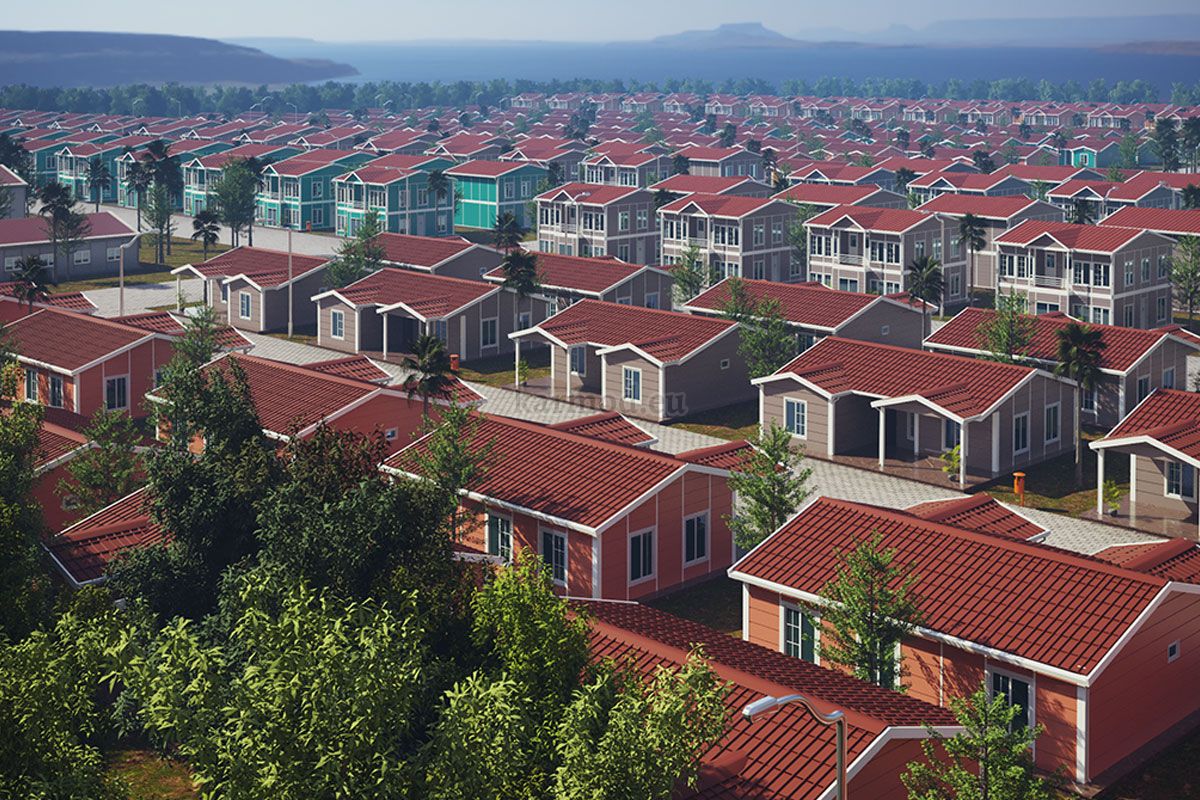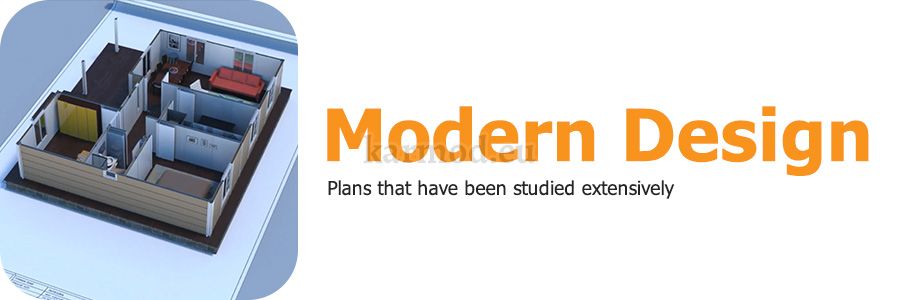
Low Cost Social Housing Projects
The increasing demand for affordable housing solutions has compelled industry leaders like Karmod to invest in innovative Low Cost Social Housing Projects. Central to this movement is the integration of modular homes. These residences, recognized for their cost and time efficiency, have become game-changers in swiftly addressing housing deficits globally. Equally transformative in this landscape are prefab homes, manufactured off-site in advance and assembled in the desired location. Beyond just cost benefits, these homes provide a unique blend of quality, speed, and the promise of affordable accommodation without compromising on modern comforts.
Low Cost Housing Technology and Techniques
In tandem with the evolving needs of communities, advancements in Low Cost Housing Technology and Techniques are setting new industry standards. Among the frontrunners in this domain is the steel house concept. Constructed primarily with steel, these homes offer durability, resistance to natural calamities, and a sustainable edge with minimal maintenance. Additionally, container homes have made a significant mark, reflecting the industry's commitment to innovative, sustainable, and cost-effective solutions. Transforming shipping containers into stylish, functional living spaces exemplifies the adaptability and forward-thinking that's shaping the future of affordable housing. With Karmod at the helm, these cutting-edge techniques ensure that quality housing remains accessible to all.
Low Cost Housing Construction Materials
In an age where housing affordability remains a pressing concern, low cost housing solutions are ever so crucial. While many factors contribute to affordable low cost housing, a significant part hinges on the choice of construction materials. Some noteworthy materials used in low cost housing construction methods include:
- Recycled materials: These play a pivotal role in sustainable low cost housing. By reusing materials, not only do costs decrease, but the environmental footprint is reduced as well.
- Bamboo and straw: Renewable and readily available, they are paramount in many low-cost housing architecture projects, especially in regions where these materials are abundant.
- Compressed Earth Blocks (CEBs): Offering cost-effective housing, these blocks utilize local soils and require less energy and cost than traditional bricks.
- Prefabricated panels: Integral in low income prefabricated houses, these panels can be mass-produced and swiftly assembled on site, reducing both time and costs.
- Local materials: Leveraging indigenous materials can substantially reduce transport costs and stimulate local economies, leading to cheap housing solutions.
Low Cost Housing Models
Around the globe, low cost housing around the world showcases a diversity of models. Each model addresses unique geographical, cultural, and economic contexts:
- Incremental housing: A low cost housing solution for governments, where residents receive a basic shelter with essential services. Over time, residents can expand and improve their homes based on their financial capabilities.
- Co-housing: Communities that emphasize shared spaces and collective ownership, often presenting affordable housing solutions around the world.
- Prefab social housing: Pre-manufactured in factories and assembled on-site, these houses offer speed, affordability, and consistent quality.
- Community land trusts: By owning the land and leasing it to homeowners, these trusts ensure affordable low-cost housing remains within the community's financial reach.

Low Cost Housing Plans
Strategic planning is essential in executing successful low cost housing developments. Here are some approaches that have been adopted worldwide:
- Slum rehabilitation: Transforming existing slums into modern low cost housing without displacing current residents.
- Social housing for sale: Offering homes at subsidized rates to eligible individuals, with the aim of providing security and stability.
- Low cost housing scheme: Often initiated by governments, these schemes provide financial incentives or subsidies to developers or potential homeowners, facilitating building low cost housing.
- Modular designs: Promoting low cost housing construction system, these plans rely on repeatable modules that can be customized based on specific needs, ensuring flexibility and affordability.
- Community participation: Engaging future residents in the design and construction process not only reduces labor costs but also instills a sense of ownership and community in the best social housing projects.
With various initiatives and technologies at play, the dream of affordable and sustainable housing is gradually becoming a tangible reality for many.
Low Cost Housing Design
The essence of low cost housing design revolves around maximizing utility, sustainability, and affordability. Incorporating low-cost housing architecture is central to achieving these goals. Key design principles include:
- Efficient space utilization: Designs must optimize space, ensuring every inch serves a purpose. Efficient layouts can make a low cost house feel spacious and functional.
- Natural ventilation and lighting: This not only reduces energy costs but also fosters sustainable low cost housing by minimizing artificial cooling and lighting needs.
- Modularity: The ability to repeat certain design elements or modules can significantly reduce design and construction costs, emphasizing the low cost housing construction system.
- Adaptability: Designing spaces that can serve multiple purposes over time can prevent future costs related to home expansion or modifications.
- Local materials: Integrating materials that are locally sourced can curtail costs and ensure the design resonates with the local culture, making the building low cost housing process more efficient.
Low Cost Housing Images
Visual representation can be an influential tool in showcasing the appeal and feasibility of low cost housing around the world. Some striking image themes that capture the essence of these homes include:
- Variety: Displaying various types of low cost housing can highlight the diversity and richness of these structures.
- Innovative designs: Pictures of homes with unique designs can emphasize the confluence of creativity and affordability in modern low cost housing.
- Context: Showing homes in different geographical, cultural, and socio-economic settings can provide a holistic understanding of low cost housing developments.
- Before and after: Such images can illustrate the transformative power of affordable housing solutions around the world.
- Construction: Photographs capturing the low cost housing construction methods can demystify the building process and showcase the integration of sustainable practices.
Low Cost Housing Inside
A peek inside a low cost house can provide invaluable insights into the efficiency and functionality of such homes. Noteworthy aspects include:
- Furniture: Multi-functional furniture can make the interiors of a compact house more versatile, reflecting cost effective housing solutions.
- Storage: Innovative storage solutions, like under-stair storage or loft beds, can demonstrate the efficacy of low-cost housing solutions.
- Natural elements: The interiors often highlight the use of natural materials, resonating with the low cost sustainable housing theme.
- Community spaces: Given the communal nature of many social housing around the world, shared spaces like courtyards or community kitchens can be focal points.
- Prefabrication: Interiors of low income prefabricated houses can highlight the seamless integration of modules and the high quality of factory-built components.
As housing becomes increasingly unaffordable in many parts of the globe, these low cost housing solutions offer a beacon of hope, ensuring that everyone has access to safe and sustainable shelter.

Low Cost Social Housing Prices
In recent years, the push towards affordable low cost housing has gained significant traction. A core segment of this movement is low cost social housing. With the increasing demand for affordable shelter, the prices of these units, while being economical, vary based on several factors:
- Location: As with all real estate, location plays a vital role in determining the price of low cost housing around the world. Urban areas, with their amenities and job opportunities, might have slightly elevated costs compared to rural regions.
- Construction Techniques: Advanced low cost housing construction methods, like prefabrication, can bring down costs. Prefab social housing, being faster to construct, often translates to savings which can affect the end price for the consumer.
- Size and Design: The prices also differ based on square footage and the complexity of low-cost housing architecture. Modular and compact designs often fetch a lower price tag.
- Government Subsidies: Many low cost housing schemes are subsidized by governments, making them more affordable for the lower-income groups. The extent of these subsidies can significantly influence the final price of the housing units.
Despite the variations in price, the overarching aim remains constant: to provide cost effective housing that doesn't compromise on quality and sustainability.

Social Housing Around the World
Social housing around the world represents a diverse tapestry of architectural styles, cultural influences, and construction techniques. From multi-story apartment complexes in European cities to single-story low income prefabricated houses in Asian suburbs, the variance is vast:
- Europe: Countries like the Netherlands and Denmark have long histories of social housing for sale. Their units often reflect modern low cost housing designs, with an emphasis on sustainability and community living.
- Asia: Rapid urbanization in countries like India and China has given rise to a variety of low cost housing developments. Prefabrication is a popular choice, given its speed and efficiency.
- Africa: With a focus on cheap housing solutions, many African nations are exploring innovative low cost housing construction systems, using local materials and passive cooling techniques.
- South America: Countries like Brazil and Argentina have integrated low cost housing solutions into their urban landscapes, with a mix of government-subsidized units and community-driven projects.
Though the designs and methods differ, the goal is universal: to offer affordable housing solutions around the world that cater to the needs of every individual, regardless of their economic status.

Low Cost Housing Solution for Governments
Governments play a pivotal role in the housing sector. With the increasing urban population and the challenges of affordability, low cost housing solution for governments has become a primary focus:
- Policy Frameworks: Enabling policies that promote low cost housing developments are essential. From offering tax incentives to developers of low cost social housing to easing land acquisition processes, the policy environment can make a significant difference.
- Partnerships: Collaborating with private developers and NGOs can amplify the impact. Joint ventures can lead to larger low cost housing schemes that cater to a broader audience.
- Technology Adoption: Embracing low cost housing technology like prefabrication or 3D printing can revolutionize the construction process, making it faster and more cost-effective.
- Land Utilization: Optimizing the use of available land, especially in urban areas, can lead to more dense and efficient housing solutions, maximizing the number of units constructed.
By actively integrating these solutions, governments can effectively address the housing challenges, ensuring their citizens have access to affordable low cost housing that is both comfortable and sustainable.
Advantages of Low Cost Housing
Low cost housing has become a pivotal solution in addressing the global housing crisis. Here are some of the standout benefits:
- Affordability: At its core, low cost housing ensures that more people can afford homes. This includes affordable low cost housing units available for different segments of society.
- Sustainability: Many low cost housing developments incorporate sustainable low cost housing techniques. This means they not only are affordable but also environmentally friendly.
- Modern Techniques: Low cost housing technology has evolved over the years, making use of innovations like prefabrication. Prefab social housing is a shining example of this, combining speed of construction with cost efficiency.
- Versatility: The types of low cost housing available are vast. From low income prefabricated houses to modern low cost housing complexes, there's something for everyone.
- Global Solutions: Low cost housing around the world showcases how different cultures and governments address housing challenges. These affordable housing solutions around the world serve as inspiration for others.
- Community Development: Many low cost housing schemes emphasize community living, ensuring that residents have shared spaces and amenities to foster social connections.

Second Hand and Used Low Cost Housing Disadvantages
While there are undeniable benefits to low cost housing, purchasing second-hand or used units does come with its set of drawbacks:
- Wear and Tear: Like any other property, low cost housing units, especially the older ones, might show signs of wear and tear which could lead to additional maintenance costs.
- Lack of Modern Amenities: Older low cost housing examples might not be equipped with the amenities and features found in newer modern low cost housing projects.
- Limited Customization: Depending on the low-cost housing architecture and construction, making renovations or customizations to a used unit can be challenging.
- Shorter Lifespan: While building low cost housing with modern techniques ensures longevity, older or used units might not have the same lifespan left, especially if they were not maintained well.
- Hidden Costs: Some second-hand cheap housing solutions might seem like a bargain initially but could have hidden issues that can result in unexpected expenses down the line.
- Outdated Construction Methods: The low cost housing construction methods used in older projects might be outdated, making them less energy efficient or sustainable compared to newer models.
Overall, while the push towards more low cost housing solutions is commendable, it's essential for buyers to carefully assess second-hand units to ensure they're making a sound investment.





